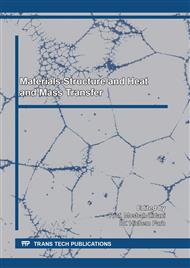[1]
M. Gousmine, D. Miroud, M.F. Benlamnouar, B. Demri, A. Younes, Study of Composite with Metallic Matrix WC/W2C–20W–20Ni Realized by Spontaneous Infiltration of the Bronze Alloy Cu–30Mn–3P, Springer, Applied Mechanics, Behavior of Materials, and Engineering Systems (2015) 365-374.
DOI: 10.1007/978-3-319-41468-3_30
Google Scholar
[2]
M. Taouinet, N. E. Kamel, S. Lebaili, Diffusion Bonding Between Zircaloy-4 and 304L Stainless Steel in the Presence of a Eutectic, Materials and Manufacturing Processes, 28: 1327–1334, (2013).
DOI: 10.1080/10426914.2013.822982
Google Scholar
[3]
M.F. Benlamnouar, M. Hadji, R. Badji, N. Bensaid, T. Saadi, Y. Laib dit Laksir, S. Senouci. Optimization of TIG Welding Process Parameters for X70-304L Dissimilar Joint Using Taguchi Method. Solid State Phenomena, Vol. 297 (2019) 51-61.
DOI: 10.4028/www.scientific.net/ssp.297.51
Google Scholar
[4]
S. Ningshen, M. Sakairi, Corrosion degradation of AISI type 304L stainless steel for application in nuclear reprocessing plant, J Solid State Electrochem (2015) 19:3533–3542.
DOI: 10.1007/s10008-015-2891-y
Google Scholar
[5]
B. Z. Margolin, I. P. Kursevich, A. A. Sorokin, N. K. Vasina, V. S. Neustroev, Embrittlement and fracture toughness of highly irradiated austenitic steels for vessel internals of wwer type reactors. Part 2. Relation between irradiation swelling And irradiation embrittlement. Physical and mechanical behavior. Strength of Materials, Vol. 42, No. 2, (2010).
DOI: 10.1007/s11223-010-9201-9
Google Scholar
[6]
G Dilip Maruthi, Purushotham, Rashmi R, Low Temperature Embrittlement studies on Stainless Steel 304LN TIG Welds, Materials Today: Proceedings 5 (2018) 2891–2900.
DOI: 10.1016/j.matpr.2018.01.083
Google Scholar
[7]
N. Bensaid, M. Hadji, R. Badji, M.F. Benlamnouar, T. Saadi, Y. Laib dit Laksir, S. Senouci. Microstructure and Mechanical Behavior of AISI 430 FSS Welds Produced with Different Elemental Metal Powder Addition. Solid State Phenomena, Vol. 297 ( 2019) 195-203.
DOI: 10.4028/www.scientific.net/ssp.297.195
Google Scholar
[8]
N. Chandrasekhar, M. Vasudevan, Intelligent Modeling for Optimization of A-TIG Welding Process, Materials and Manufacturing Processes, 25: 1341–1350, (2010).
DOI: 10.1080/10426914.2010.529584
Google Scholar
[9]
Vasudevan Muthukumaran, Nagaraju Sa, P. Vasantharaja, N. Chandrasekhar, T.Jayakumar, Optimization of Welding Process Parameters for 9Cr-1Mo Steel Using RSM and GA, Materials and Manufacturing Processes, Volume 31, Issue 3 319-327, (2016).
DOI: 10.1080/10426914.2015.1025974
Google Scholar
[10]
Berkani, S., Yallese, M., Boulanouar, L., & Mabrouki, T. (2015). Statistical analysis of AISI304 austenitic stainless steel machining using Ti (C, N)/Al2O3/TiN CVD coated carbide tool. International Journal of Industrial Engineering Computations, 6(4), 539-552.
DOI: 10.5267/j.ijiec.2015.4.004
Google Scholar
[11]
Zahia, H., Athmane, Y., Lakhdar, B., & Tarek, M. (2015). On the application of response, surface methodology for predicting and optimizing surface roughness and cutting forces in hard turning by PVD coated insert. International Journal of Industrial Engineering Computations, 6(2), 267-284.
DOI: 10.5267/j.ijiec.2014.10.003
Google Scholar
[12]
Xuemei Sun, Guoqun Zhao , Cunsheng Zhang, Yanjin Guan, Anjiang Gao, Optimal Design of Second-Step Welding Chamber for a Condenser Tube Extrusion Die Based on the Response Surface Method and the Genetic Algorithm, Materials and Manufacturing Processes, 28: 823–834, (2013).
DOI: 10.1080/10426914.2012.736657
Google Scholar
[13]
ASME. Qualification Standard for Welding and Brazing, An International Code of ASME Boiler and Pressure Vessel Committee on welding and Brazing, USA, (2010).
DOI: 10.1115/1.859872.ch25
Google Scholar
[14]
ASTM International E08-03, Standard test methods for tension testing of metallic materials, American National Standard, E8/E8M, (2010).
Google Scholar
[15]
Aouici H, Yallese MA, Belbah A, Ameur MF, Elbah M (2013) Experimental investigation of cutting parameters influence on surface roughness and cutting forces in hard turning of X38CrMoV5-1 with CBN tool. Sadhana 38(3):429–445.
DOI: 10.1007/s12046-013-0147-z
Google Scholar
[16]
V. N. Gaitonde, S. R. Karnik, M. Faustino and J. P. Davim, Machinability analysis in turning tungsten-copper composite for application in EDM electrodes, I. J. Refractory Metals & Hard Materials, 27 (2009) 754-763.
DOI: 10.1016/j.ijrmhm.2009.10.002
Google Scholar
[17]
Haijin W, Jie S, Jianfeng L, Laixiao L, Nan L (2016) Evaluation of cutting force and cutting temperature in milling carbon fiberreinforced polymer composites. Int J Adv Manuf Technol 82(9):1517–1525.
DOI: 10.1007/s00170-015-7479-2
Google Scholar
[18]
Montgomery D C;Design and Analysis of experiments.4th ed. John Wiley and Sons.New York, (1997).
Google Scholar
[19]
Kumar P, Chauhan SR (2015) Machinability study on finish turning of AISI H13 hot working die tool steel with cubic boron nitride (CBN) cutting tool inserts using response surface methodology (RSM). Arab J Sci Eng 40:1471–1485.
DOI: 10.1007/s13369-015-1606-0
Google Scholar
[20]
R.H. Myers, D.C. Montgomery, Response Surface Methodology Process and Product Optimization Using Designed Experiments, second ed., JohnWiley and Sons, Inc., New York, (2002).
Google Scholar
[21]
Shahrajabian H, Farahnakian M (2013) Modeling and multiconstrained optimization in drilling process of carbon fiber reinforced epoxy composite. Int J Precis Eng Manuf 14:1829–1837.
DOI: 10.1007/s12541-013-0245-1
Google Scholar


